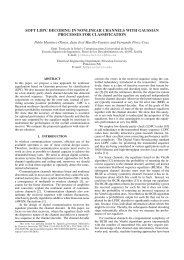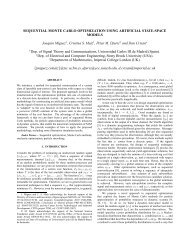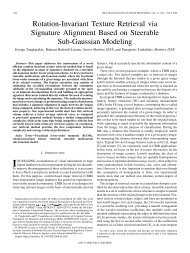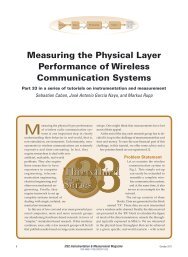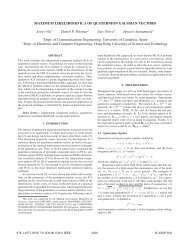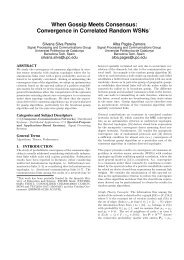Untitled - COMONSENS
Untitled - COMONSENS
Untitled - COMONSENS
You also want an ePaper? Increase the reach of your titles
YUMPU automatically turns print PDFs into web optimized ePapers that Google loves.
19th European Signal Processing Conference (EUSIPCO 2011) Barcelona, Spain, August 29 - September 2, 2011<br />
PERFORMANCE EVALUATION OF NON-LINEAR MIMO PRECODERS UNDER<br />
TRANSMIT IMPAIRMENTS<br />
José P. González–Coma, Paula M. Castro, José A. García–Naya, and Luis Castedo<br />
Universidade da Coruña, Campus de Elviña s/n, 15071. A Coruña, Spain<br />
Email: jgonzalezcoma@gmail.com,{pcastro, jagarcia, luis}@udc.es<br />
ABSTRACT<br />
This work analyzes the impact of radio frequency transmitter<br />
impairments on the performance of Multiple–<br />
Input Multiple–Output (MIMO) systems with nonlinear<br />
Tomlinson–Harashima and vector precoding. This analysis is<br />
carried out by means of simulation results using two sorts of<br />
scenarios: spatially-white Rayleigh channels and measured<br />
indoor channels. We also show that incorporating the transmitter<br />
noise in the precoder design produces a significant performance<br />
improvement.<br />
1. INTRODUCTION<br />
Practical implementations of wireless communication transmitters<br />
suffer from a large number of impairments such as<br />
quantization noise, sampling offset, phase noise, I/Q imbalance<br />
..., which are normally ignored when designing<br />
Multiple–Input Multiple–Output (MIMO) signaling methods.<br />
However, it is shown in [1, 2] that noise generated at<br />
the transmitter can significantly affect predicted MIMO system<br />
performance. In this work, the impact of residual transmitter<br />
noise is evaluated by means of two sorts of scenarios:<br />
spatially-white Rayleigh channels and measured indoor<br />
channels obtained using a MIMO testbed developed at the<br />
University of A Coruña [3]. This latter scenario is specially<br />
outstanding to illustrate the influence of transmitter noise<br />
on real-world situations. We only consider MIMO nonlinear<br />
schemes since their performance is clearly much better<br />
than the respective linear ones. More specifically, we focus<br />
on Tomlinson–Harashima Precoding (THP) [4,5] and Vector<br />
Precoding (VP) [6]. THP solves the malicious effect of feeding<br />
back worng decisions inherent to the wellknown Decision<br />
Feedback (DF) receivers by performing a similar task at<br />
transmission. Correspondingly, VP performs a lattice search<br />
at transmission similar to that carried out by Maximum Likelihood<br />
(ML) detectors. Contrary to linear precoders, transmitter<br />
impairments significantly affect the performance of<br />
nonlinear THP and VP [7, 8]. However, we will show that<br />
this performance degradation can be greatly alleviated if the<br />
transmitter noise is incorporated in the precoder design.<br />
This work is organized as follows. Section 2 describes<br />
the way of modeling the aforementioned transmitter impairments.<br />
Sections 3 and 4 respectively explain the design of<br />
THP and VP when transmitter noise is included into filter<br />
optimizations. Finally, computer simulations are shown in<br />
Section 5 and some concluding remarks are stated in Section<br />
6.<br />
2. SIGNAL MODEL WITH TX-NOISE<br />
When considering a non-ideal transmitter affected by residual<br />
transmitter noise, the transmitted symbols are modeled<br />
as<br />
x t [n]=x[n]+η t [n] ∈ C N ,<br />
where N is the number of transmit antennas and η t [n] is the<br />
transmitter noise, which will be referred to as Tx-noise. According<br />
to [2], Tx-noise is accurately modeled as an additive<br />
Gaussian-distributed noise, i.e. η t ∼ N C (0,C ηt ), where<br />
C ηt is the Tx-noise covariance matrix. It is also assumed<br />
that Tx-noise is independent from the transmitted signals.<br />
Correspondingly, we define the Signal–to–Tx-Noise Ratio<br />
(STxNR) as<br />
STxNR =<br />
E tx<br />
tr(C ηt ) ,<br />
where E tx is the transmit energy and tr(•) denotes the trace<br />
operator. In practical implementations, typical values of<br />
STxNR range between 22dB and 32dB [2].<br />
3. MIMO THP DESIGN WITH TX-NOISE<br />
Figure 1 shows the block diagram of a MIMO system with K<br />
receive antennas employing THP, which is a nonlinear precoding<br />
technique made up of a feedforward filter F ∈ C N×K ,<br />
a feedbackward filter I − B ∈ C K×K , and a modulo operator,<br />
denoted in Fig. 1 by M(•). The modulo operator is<br />
introduced to avoid the increase in transmit power due to the<br />
feedback loop [4]. Therefore, the modulo operator constrains<br />
the real and imaginary part of the signal at its input to the interval<br />
[−/2,/2] by adding integer multiples of and j to<br />
the real and imaginary part, respectively. Note that the parameter<br />
depends on the modulation. In the particular case<br />
of QPSK modulation, = 2 √ 2. Data symbols sent from the<br />
transmitter to the K antenna receiver will be represented by<br />
u[n] ∈ A K , where A denotes the modulation alphabet. The<br />
ordering considerably affects the performance of THP and<br />
for this reason, transmit symbols are passed through a permutation<br />
filter P . Minimization is carried out under the restriction<br />
of B being a spatially causal filter and constrained transmit<br />
energy (i.e. E[‖x[n]‖ 2 2 ]=E tr) where x[n]=Fv[n] ∈ C N<br />
with v[n] representing the output of the modulo operator in<br />
the transmit signal.<br />
At reception, we assume that all acquired signals are<br />
scaled by the same positive real-valued factor g. This<br />
assumption is necessary in order to arrive at closed-form<br />
and unique solutions for the Minimum Mean Square Error<br />
(MMSE) THP design. According to our signal model, the<br />
received signal is<br />
ˆ d t [n]= ˆ d[n]+gHη t [n] ∈ C K ,<br />
where ˆ d[n]=gHFv[n]+gη r [n] is the received signal when<br />
there is no Tx-noise. At the receiver, the modulo operator<br />
© EURASIP, 2011 - ISSN 2076-1465 799
u[n]<br />
P v[n] F x[n] x t [n] H gI dˆ<br />
t [n]<br />
M(•)<br />
M(•)<br />
û[n]<br />
Q(•)<br />
ũ[n]<br />
I − B<br />
η t [n]<br />
η r [n]<br />
Figure 1: Block diagram of Tomlinson-Harashima precoding with Tx-noise.<br />
is applied again to invert the effect of this operator at the<br />
transmitter and the resulting signal is passed through a symbol<br />
detector (represented by Q(•) in Fig. 1) to produce the<br />
detected symbols ũ[n] ∈ A K .<br />
As explained in [5], the MMSE THP design searches for<br />
the filtering and permutation matrices that minimize the variance<br />
of the error vector<br />
ɛ t [n]=P T Bv[n] − ˆd t [n]=ɛ[n] − gHη t [n], (1)<br />
where ɛ[n]=P T Bv[n]−gy[n] is the error vector when there<br />
is no Tx-noise.<br />
Since transmitter noise is independent from transmitted<br />
signals and receiver noise, the MSE can be decomposed as<br />
MSE t,THP = MSE THP + |g| 2 tr(HC ηt H H ), (2)<br />
where MSE THP = E[||ɛ[n]|| 2 2 ] is the MSE when there is no<br />
Tx-noise, which constitutes the cost function that is minimized<br />
in the conventional MMSE design of THP [5], and<br />
MSE t,THP = E[||ɛ t [n]|| 2 2 ] is the resulting MSE under transmitter<br />
noise conditions, with the error vector ɛ t [n] defined in<br />
Eq. (1). C ηr = E[η r [n]ηr H [n]] is the spatial covariance matrix<br />
of the Additive White Gaussian Noise (AWGN) at the<br />
receiver (so-called receiver noise, which is referred to as Rxnoise).<br />
Following similar derivations to those in [5], the minimization<br />
of the MSE cost function of Eq. (2), subject to the<br />
mentioned constraints, can be carried out by means of the<br />
factorization of<br />
where<br />
Φ t =(HH H + t I) −1 ,<br />
t = + tr(HC ηt H H )/E tx , (3)<br />
with = tr(C ηr )/E tx [5]. The symmetrically permuted Cholesky<br />
decomposition of this matrix is<br />
PΦ t P T = L H DL, (4)<br />
where L and D are, respectively, unit lower triangular and<br />
diagonal matrices. Finally, the MMSE solution for the THP<br />
filters that account for the Tx-noise is given by<br />
FMMSE THP = g THP,−1<br />
MMSE HH P T L H D<br />
BMMSE THP = L −1 .<br />
The receive scalar weight g THP<br />
MMSE<br />
is directly obtained from<br />
the transmit energy constraint. Assuming that it is realvalued<br />
and positive, it is obtained that<br />
√<br />
g THP<br />
MMSE = tr(H H P T L H D 2 C v LP H)<br />
,<br />
E tx<br />
where C v is the covariance matrix of v[n], which is diagonal<br />
with entries depending on the modulation alphabet [4].<br />
The minimum value for the MSE cost function given by<br />
Eq. (2) can be obtained by substituting the expressions obtained<br />
for the optimum filters FMMSE THP and BTHP<br />
MMSE<br />
, and for<br />
the gain factor g THP<br />
MMSE<br />
. It is easy to show that the final MMSE<br />
under the presence of Tx-noise is given by<br />
MMSE THP = t tr(C v D), (5)<br />
where t is given by Eq. (3) and D is the diagonal matrix that<br />
results from the permuted Cholesky factorization of Eq. (4).<br />
As done in [9], instead of testing all possible permutation<br />
matrices to find the one that minimizes the cost function of<br />
Eq. (5), the ordering optimization (given by the permutation<br />
matrix P ) is included into the computation of the Cholesky<br />
decomposition of Eq. (4) (see [9]).<br />
As in [5], it is straightforward to obtain the expressions<br />
for the ZF-THP design as the limiting case when t → 0. The<br />
expressions for the filters F THP and B THP are equal to that<br />
ZF<br />
MMSE<br />
and BTHP<br />
MMSE<br />
obtained for F THP<br />
, respectively, although the<br />
matrices P , L, and D should be obtained from the symmetrically<br />
permuted Cholesky factorization of<br />
Φ t =(HH H ) −1 .<br />
4. MIMO VP DESIGN WITH TX-NOISE<br />
Figure 2 shows the block diagram of a MIMO system including<br />
a vector precoder. The transmitter has the freedom<br />
to add an arbitrary perturbation signal a[n] ∈ Z K + jZ K to<br />
the data signal prior to linear transformation with the filter<br />
F ∈ C N×K , since the receiver applies the modulo operator<br />
M(•). As in THP, denotes a constant that depends on the<br />
modulation alphabet associated with the modulo operator.<br />
As it can be seen from Fig. 2, the data vector u[n] ∈ C K<br />
is first superimposed with the perturbation vector a[n], and<br />
the resulting vector is then processed by the linear filter F to<br />
form the transmit vector x[n] =Fd[n] ∈ C N , where d[n] is<br />
the desired signal given by u[n]+a[n] and n is the symbol<br />
index in a block size of N B data symbols. The transmit energy<br />
constraint is expressed as N B<br />
n=1 ||x[n]||2 2 /N B ≤ E tx since<br />
transmit symbols statistics are unknown.<br />
The weight g in Fig. 2 is assumed to be constant throughout<br />
the block of N B symbols. Again, note that we use a common<br />
weight for all the receive antennas. Thus, the weighted<br />
estimated signal is given by<br />
ZF<br />
ˆ d t [n]= ˆ d[n]+gHη t [n],<br />
with ˆ d[n] =gHFd[n]+gη[n]. The modulo operator at the<br />
receiver is used to compensate the effect of adding the perturbation<br />
a[n] at the transmitter.<br />
The procedure to obtain the optimum VP parameters is<br />
the following. We start by fixing a, after which x and g are<br />
800
u[n]<br />
d[n]<br />
F<br />
H<br />
gI<br />
ˆ d t [n]<br />
M(•)<br />
û[n]<br />
Q(•)<br />
ũ[n]<br />
a[n]<br />
η t [n]<br />
η r [n]<br />
Figure 2: Block diagram of vector precoding with Tx-noise.<br />
optimized taking into account the transmit power constraint.<br />
5. SIMULATION RESULTS<br />
For these optimum x and g we choose the best a according<br />
to the Mean Square Error (MSE) criterion [6].<br />
In this section, the results of several computer simulations<br />
As it is demonstrated in [6], the MSE can be expressed<br />
are presented to illustrate the impact of Tx-noise on the<br />
as<br />
performance of the MIMO precoding schemes described<br />
MSE t,VP = MSE VP + 1 N B<br />
in the previous sections. We consider two types of channels:<br />
synthetically-generated spatially-white Rayleigh chan-<br />
N B<br />
‖gHη t [n]‖ 2 2 , (6)<br />
n=1<br />
nels and channels measured using a testbed in an indoor scenario<br />
at the University of A Coruña [3] by considering N = 4<br />
where MSE VP = N B<br />
n=1 E[||d[n] − d[n]|| ˆ 2 2 |u[n]]/N B with no<br />
Tx-noise, and MSE t,VP = N B<br />
n=1 E[||d[n] − ˆd t [n]|| 2 2 |u[n]]/N and K = 4 transmit and receive antennas, respectively. The<br />
B, performance metric is the uncoded Bit Error Rate (BER) versus<br />
the Signal–to–Rx-Noise Ratio (SRxNR) defined as<br />
otherwise. Then, we reach the following solution for the<br />
MMSE vector precoder<br />
x VP<br />
(<br />
MMSE [n]=g−1,VP MMSE H H H + t I ) −1<br />
H H d[n]<br />
SRxNR =<br />
E txK<br />
√<br />
tr(C ηr ) ,<br />
g VP<br />
MMSE = N B<br />
n=1 dH [n]H (H H H + t I) −2 H H d[n]<br />
,<br />
where C ηr is the Rx-noise covariance matrix. The Rx-noise<br />
E tx N B is also assumed to be statistically independent from the Txnoise.<br />
We assume the presence of residual Tx-impairments<br />
(7)<br />
that produce a STxNR of 25dB, which lies in the practical<br />
where g VP<br />
MMSE<br />
is directly obtained from the transmit energy range between 22dB and 32dB. The symbols are QPSK<br />
constraint.<br />
modulated and it is also assumed that C u = I. The channel is<br />
By defining the matrix Φ t =(HH H + t I) −1 and applying<br />
the matrix inversion lemma to x VP<br />
MMSE<br />
quasi-static and remains unchanged during the transmission<br />
[n] in Eq. (7), the of a symbol frame, although it changes in an statisticallyindependent<br />
fashion between frames.<br />
MSE expression of Eq. (6) is reduced to [6]<br />
MMSE t,VP = N B<br />
t<br />
N B<br />
d H 5.1 Results for Spatially-White Rayleigh Channels<br />
[n]Φ t d[n].<br />
n=1<br />
Figures 4 and 5 plot BER versus SRxNR for a 4 × 4 MIMO<br />
Since Φ t is positive definite, we can use the Cholesky factorization<br />
to obtain a lower triangular matrix L and a diagonal<br />
system with THP and VP setups, respectively. The channel<br />
has been synthetically generated from a set of i.i.d. complexvalued<br />
Gaussian random variables (i.e. it is a spatially-white<br />
matrix D with the following relationship [6],<br />
Φ t = ( HH H + t I ) MIMO Rayleigh channel). In this subsection we assumed<br />
−1<br />
= L H DL.<br />
both receiver and transmitter noise are spatially-white, i.e.<br />
C ηt = t 2<br />
Thus, the perturbation signal can be found by the following<br />
I and C η r<br />
= r 2 I. A hundred channel realizations<br />
are considered with frames of 10 6 symbols.<br />
search [6]<br />
Note that the impact of the Tx-noise is extremely important<br />
on the performance of THP, as shown in Fig 4.<br />
a VP<br />
MMSE [n]= argmin (u[n]+a[n]) H Φ t (u[n]+a[n])<br />
a[n]∈Z K +jZ K The performance of conventional THP severely degrades for<br />
= argmin ||D 1/2 L(u[n]+a[n])|| 2 2 , SRxNR values above 25dB, where Tx-noise causes an error<br />
floor of about 10 −3 . As it can be seen from the figure,<br />
a[n]∈Z K +jZ K the classical MMSE curve with Tx-noise goes up again at<br />
which can be solved by means of the Schnorr-Euchner sphere high SRxNR since MMSE-THP converges to ZF-THP, which<br />
decoding algorithm [10, 11]. The successive computation of is much more sensitive to noise. Notice that the effect of<br />
a[n] leads to the suboptimum approach of THP described Tx-noise could be seen as an additive and coloured noise at<br />
above.<br />
the receiver. However, note that including Tx-noise into the<br />
The ZF constraint E[ d[n]| ˆ d[n]] = gHFd[n], for n = MMSE-THP design greatly alleviates this problem and the<br />
1,...,N B , leads to similar expressions for x VP<br />
ZF [n] and gVP error floor is reduced to a residual value of about 10 −7 . For<br />
ZF<br />
as those obtained for the MMSE-VP desgn in Eq. (7) but vector precoding, as it can be seen from Fig 5, the BER performance<br />
is much less affected by Tx-noise than in the case<br />
considering t → 0. Following similar steps as before, the<br />
MMSE for ZF-VP has exactly the same form as for MMSE- of THP. Nevertheless, the inclusion of Tx-noise in filter optimizations<br />
improves the performance achieved by classical<br />
VP redefining Φ t as (HH H ) −1 . Finally, the optimum perturbation<br />
vectors are found by the following closest point search VP designs in 1dB at a BER of 10 −6 .<br />
in a lattice [6]<br />
∥<br />
a VP<br />
∥∥H H<br />
ZF[n]= argmin<br />
( HH H) ∥ 5.2 Results for Measured Indoor Channels<br />
−1 ∥∥<br />
2<br />
d[n] . We also carried out computer experiments considering channels<br />
measured in a realistic indoor scenario with a a[n]∈Z K + jZ K 2<br />
testbed<br />
801
⎡<br />
⎤<br />
1.2058 −0.0104 + 0.0079i −0.0030 + 0.0141i 0.0212 − 0.0040i<br />
Ĉ ηr = 10 2 ⎢−0.0104 − 0.0079i 0.9973 0.0119 + 0.0061i 0.0043 − 0.0038i ⎥<br />
× ⎣<br />
−0.0030 − 0.0141i 0.0119 − 0.0061i 0.6265 −0.0007 + 0.0076i<br />
⎦,<br />
0.0212 + 0.0040i 0.0043 + 0.0038i −0.0007 − 0.0076i 1.1025<br />
⎡<br />
⎤<br />
2.6069 0.0810 − 0.0115i 0.0058 + 0.0068i −0.0107 + 0.0001i<br />
Ĉ ηt = 10 −3 ⎢ 0.0081 + 0.0115i 2.6413 0.0020 + 0.0020i −0.0127 + 0.0035i ⎥<br />
× ⎣<br />
0.0058 − 0.0068i 0.0020 − 0.0020i 2.5552 0.0037 + 0.0018i<br />
⎦.<br />
−0.0107 − 0.0001i −0.0127 − 0.0035i 0.0037 − 0.0018i 3.4155<br />
Figure 3: Transmitter and receiver noise covariance matrices estimated using the testbed.<br />
10 <br />
10 <br />
<br />
<br />
<br />
<br />
10 <br />
10 <br />
<br />
<br />
<br />
<br />
uncoded BER<br />
10 <br />
10 <br />
10 <br />
<br />
<br />
<br />
<br />
<br />
Modified<br />
<br />
<br />
uncoded BER<br />
10 <br />
10 <br />
10 <br />
<br />
<br />
<br />
<br />
<br />
<br />
10 <br />
10 0 SRxNR [dB]<br />
10 15 20 25 30 35 40 45<br />
10 <br />
10 0 SRxNR [dB]<br />
10 <br />
Figure 4: BER vs. SRxNR with Tomlinson-Harashima over<br />
spatially-white Rayleigh channels.<br />
developed at the University of A Coruña [3]. The testbed is<br />
made up of two PCs, one for the transmitter and one for the<br />
receiver. Each PC contains the baseband hardware plus the<br />
Radio-Frequency Front-End (RF-FE). The baseband hardware<br />
is composed of fast memories, which can be accessed at<br />
the speed of the A/D and D/A converters, thus allowing the<br />
transmission and subsequent acquisition of signals in realtime.<br />
However, the signal processing at both transmitter and<br />
receiver sides is performed off-line.<br />
With the goal of obtaining statistically rich channel realizations,<br />
and given that the utilized RF-FE is frequency-agile,<br />
we measure at different RF carriers in the frequency interval<br />
ranging from 5219MHz to 5251MHz and from 5483MHz<br />
to 5703MHz. Carrier spacing is 4MHz (greater than the<br />
signal bandwidth, which is equal to 1.12MHz), resulting in<br />
65 different frequencies. Additionally, we repeat the whole<br />
measurement procedure for four different positions of the receiver,<br />
giving as a result 260 channel realization measurements.<br />
After normalization, channel matrices have a mean<br />
Frobenius norm equal to NK = 16.<br />
Figure 6 shows the frame structure, where a Pseudo-<br />
Noise (PN) sequence of 119 symbols is added as a preamble<br />
for synchronization together with a silence of 50 symbols.<br />
The receiver noise covariance matrix Ĉ ηr is calculated<br />
based on the observations acquired during the silence after<br />
the preamble. On the other hand, both the MIMO channels<br />
and the total noise covariance matrix Ĉ ηtot were esti-<br />
Figure 5: BER vs SRxNR with vector precoding over<br />
spatially-white Rayleigh channels.<br />
PN (preamble)<br />
training sequence (pilot symbols)<br />
119 symbols 50 symbols<br />
4000 symbols (per transmit antenna)<br />
4.19 ms<br />
Figure 6: Frame structure used by the measurement procedure.<br />
mated during the transmission of the training sequence. The<br />
transmitter noise covariance matrix is directly obtained from<br />
Ĉ ηtot = ĤĈ ηt Ĥ H +Ĉ ηr by performing Ĉ ηt = Ĥ −1 (Ĉ ηtot −<br />
Ĉ ηr )Ĥ −H . Figure 3 shows the receiver and transmitter<br />
noise covariance matrices obtained from the testbed measurements.<br />
These covariance matrices are plugged into the<br />
THP and VP filter expressions derived in the previous sections.<br />
Simulated Gaussian noise was additionally injected to<br />
change the operating SRxNR value.<br />
Figure 7 plots the BER performance in terms of SRxNR<br />
for MIMO systems with both MMSE- and ZF-THP when<br />
transmitting over indoor channels obtained from the testbed.<br />
Two hundred and sixty channel realizations are considered<br />
with frames of 10 5 symbols. Again, note the high sensitivity<br />
of the performance of MIMO systems with THP with respect<br />
to Tx-noise. The performance of both MMSE- and ZF-THP<br />
is considerably degraded due to Tx-noise and an error floor<br />
arises at the significant BER value of 2 × 10 −3 . This error<br />
floor can be reduced to the BER value of 3 × 10 −6 when Txnoise<br />
is considered in the design. The same effect is observed<br />
for VP over indoor channels but at lower values of BER since<br />
802
uncoded BER<br />
uncoded BER<br />
10 0 Modified ZF-THP<br />
with Tx-noise<br />
10 <br />
Classical ZF-THP<br />
with no Tx-noise<br />
10 <br />
Classical MMSE-THP<br />
10 with Tx-noise<br />
10 <br />
Modified MMSE-THP<br />
with Tx-noise<br />
10 <br />
Classical MMSE-THP<br />
with no Tx-noise<br />
10 <br />
0 5 10 15 20 25 30 35 40<br />
SRxNR [dB]<br />
Figure 7: BER vs. SRxNR with Tomlinson-Harashima precoding<br />
over measured indoor channels.<br />
10 0 Modifi<br />
<br />
10 <br />
<br />
10 <br />
<br />
10 <br />
<br />
10 <br />
Modifi<br />
10 <br />
<br />
<br />
10 <br />
0 5 10 15 20 25 30 35 40<br />
SRxNR [dB]<br />
Figure 8: BER vs. SRxNR with vector precoding over measured<br />
indoor channels.<br />
VP is optimal with respect to THP and not so influenced by<br />
noise impairments at the transmitter because of the correction<br />
performed by the lattice search. Figure 9 shows the histogram<br />
of the modulus and the angle of the measured MIMO<br />
channel coefficients. While the angle follows an uniform distribution,<br />
the modulus is clearly not Rayleigh. This explains<br />
the differences in performance between the case of measured<br />
indoor channels and that of spatially-white channels in the<br />
previous subsection.<br />
6. CONCLUSIONS<br />
This work investigates the impact of noise generated by<br />
practical transmitters on the performance of MIMO systems<br />
with nonlinear THP and VP. We have shown that Tx-noise<br />
severely degrades the performance of both precoding methods<br />
although their performance can be significantly improved<br />
if Tx-noise is included in precoder designs.<br />
0.6<br />
0.5<br />
0.4<br />
0.3<br />
0.2<br />
0.1<br />
estimated pdf<br />
Rayleigh pdf<br />
0<br />
-1 0 1 2 3 4 5 6 7<br />
standard unit<br />
0.4<br />
0.3<br />
0.2<br />
0.1<br />
0<br />
-2 -1 0 1 2<br />
standard unit<br />
Figure 9: Histogram of the module (left-hand) and the angle<br />
(right-hand) of the estimated channel coefficients.<br />
Acknowledgments<br />
This work has been funded by Xunta de Galicia, Ministerio de<br />
Ciencia e Innovación of Spain, and FEDER funds of the European<br />
Union under grants with numbers 10TIC003CT, 09TIC008105PR,<br />
TEC2010-19545-C04-01, and CSD2008-00010.<br />
REFERENCES<br />
[1] H. Suzuki, T.V.A. Tran, I.B. Collings, G. Daniels, and<br />
M. Hedley, “Transmitter Noise Effect on the Performance<br />
of a MIMO-OFDM Hardware Implementation Achieving Improved<br />
Coverage,” IEEE Journal on Selected Areas in Communications,<br />
vol. 26, no. 6, pp. 867–876, Aug. 2008.<br />
[2] C. Studer, M. Wenk, and A. Burg, “MIMO Transmission with<br />
Residual Tx-RF Impairments,” International ITG Workshop<br />
on Smart Antennas, pp. 189–196, February 2010.<br />
[3] J. A. García-Naya, M. González-López, and L. Castedo, Radio<br />
Communications, chapter A Distributed Multilayer Software<br />
Architecture for MIMO Testbeds, In-Tech, Apr. 2010.<br />
[4] R. F. H. Fischer, Precoding and Signal Shaping for Digital<br />
Transmission, John Wiley & Sons, 2002.<br />
[5] M. Joham, Optimization of Linear and Nonlinear Transmit<br />
Signal Processing. PhD dissertation, Munich University of<br />
Technology, 2004.<br />
[6] D. A. Schmidt, M. Joham, and W. Utschick, “Minimum Mean<br />
Square Error Vector Precoding,” European Transactions on<br />
Telecommunications, vol. 19, no. 3, pp. 219–231, March/April<br />
2008.<br />
[7] J. González-Coma, P. Castro, and L. Castedo, “Impact<br />
of transmit impairments on multiuser mimo non-linear<br />
transceivers,” in Proc. International ITG Workshop on Smart<br />
Antennas, February 2011.<br />
[8] J. González-Coma, P. Castro, and L. Castedo, “Transmit impairments<br />
influence on the performance of mimo receivers and<br />
precoders,” in Proc. European Wireless, April 2011.<br />
[9] K. Kusume, M. Joham, W. Utschick, and G. Bauch,<br />
“Cholesky factorization with symmetric permutation applied<br />
to detecting and precoding spatially multiplexed data<br />
streams,” IEEE Transactions on Signal Processing, vol. 55,<br />
no. 6, pp. 3089–3103, June 2007.<br />
[10] C. P. Schnorr and M. Euchnerr, “Lattice basis reduction:<br />
Improved practical algorithms and solving subset sum problems,”<br />
Math. Programming, vol. 66, pp. 188–191, September<br />
1994.<br />
[11] M. O. Damen, H. El Gamal, and G. Caire, “On maximumlikelihood<br />
detection and the search for the closest lattice<br />
point,” IEEE Transactions on Information Theory, vol. 49,<br />
no. 10, pp. 2389–2402, 2003.<br />
803



